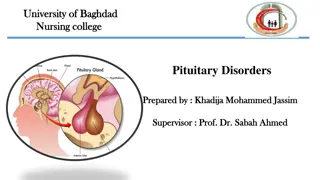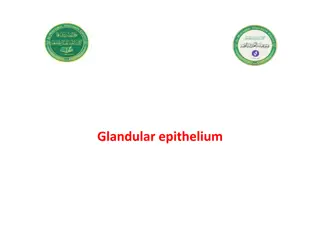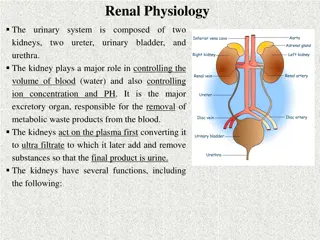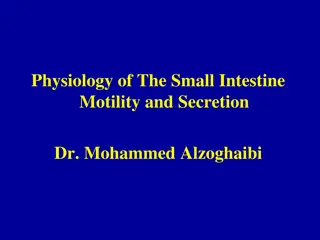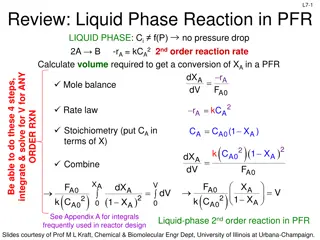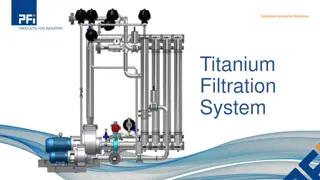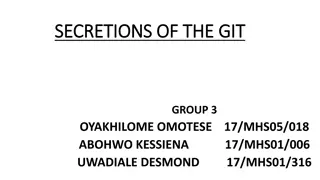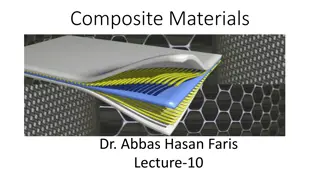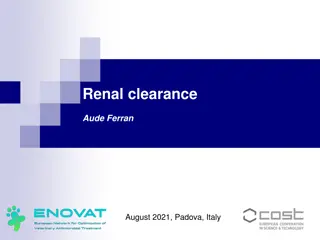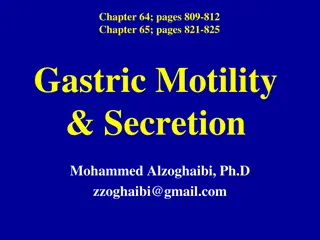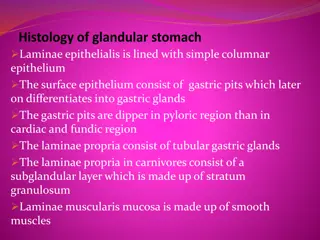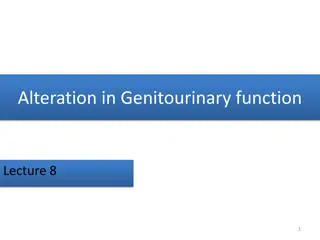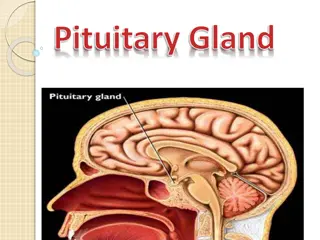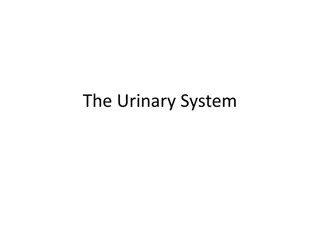Hyperparathyroidism
Hyperparathyroidism is characterized by overactive parathyroid glands leading to excessive secretion of parathyroid hormone and elevated blood calcium levels. This condition can cause symptoms like excessive urination, abdominal pain, weakness, and more. Primary hyperparathyroidism is often due to n
0 views • 20 slides
Pituitary Disorders
Pituitary disorders, often caused by tumors, can disrupt hormone production leading to various symptoms like weight gain, vision problems, and hormonal imbalances. The pituitary gland plays a crucial role in regulating bodily functions through hormone secretion. Factors such as tumor growth, head in
0 views • 25 slides
Peptic Ulcer Disease: Treatment Approaches and Helicobacter pylori Eradication
Common gastrointestinal conditions such as peptic ulcers can be effectively treated through approaches like eradicating H. pylori infection, reducing gastric acid secretion, and using mucosal protecting agents. Helicobacter pylori eradication is crucial for healing ulcers and preventing recurrence,
1 views • 27 slides
The lacrimal system
Disorders of the lacrimal system can lead to chronic symptoms affecting the eyes, causing discomfort and vision problems. Common abnormalities include dry eye, which can result from tear flow and evaporation issues. Aqueous-deficient dry eye, often associated with Sjögren's syndrome, is characteriz
3 views • 38 slides
Understanding Urinary Elimination: Anatomy, Physiology, and Function of the Kidneys
The lecture covers the fundamentals of urinary elimination focusing on the kidneys' location, structure, function, and the role of nephrons. It discusses the transport of urine through the ureters to the bladder, highlighting the bladder's muscle layers and the urethra's role in expelling urine. Stu
3 views • 37 slides
Understanding Renal Function Tests: Lecture Insights on Kidney Function and Structure
This lecture delves into the essential aspects of renal function tests, exploring the functional units of the kidney, the role of nephrons in maintaining homeostasis, and the intricate processes of filtration, reabsorption, and secretion within the renal tubules. Key topics include the hormonal and
4 views • 17 slides
Physiologie Digestive PHASE BUCCALE
Digestive physiology involves the breakdown of food into simple nutrients for absorption by the body. It includes mechanical and chemical means of food degradation using enzymes from salivary, gastric, pancreatic, and colonic bacteria. The digestive system comprises the mouth, esophagus, stomach, li
4 views • 25 slides
Comprehensive Overview of Pancreas Function and Structure
Pancreas is a vital organ in the abdomen with dual exocrine and endocrine functions. As an exocrine organ, it secretes digestive enzymes and bicarbonates into the duodenum for food breakdown. In its endocrine role, the pancreas regulates blood sugar levels by secreting insulin, glucagon, somatostati
1 views • 16 slides
The Future of Heating with Open Coil and Tubular Technology!
Explore the world of industrial heating solutions with our comprehensive guide on maximizing heat output using open coil and tubular heaters. Discover the benefits, applications, and key differences between these two versatile heating options. Whether you're in HVAC, manufacturing, or chemical proce
1 views • 7 slides
The Role of Quality Control in Tubular Heater Manufacturing Success
Tubular heaters are essential components in various industries, from domestic appliances to industrial machinery. Ensuring their reliability and efficiency is paramount for manufacturers, making quality control techniques crucial. This comprehensive guide delves into the various quality control meth
0 views • 7 slides
How Manufacturers Make Tubular Heaters Last Longer!
Tubular Heater Manufacturers are specialized companies that design, produce, and supply tubular heaters, which are essential components in a variety of industrial and commercial heating applications. These manufacturers focus on creating durable, efficient, and customizable heating solutions to meet
0 views • 9 slides
Understanding Female Reproduction System
The female reproduction system plays a crucial role in producing fertile eggs, hormones, and facilitating fertilization, pregnancy, and birth. Key terms like estrous and estrus, ovulation, and folliculogenesis are essential to grasp. The female reproductive tract consists of tubular organs like the
0 views • 27 slides
Understanding Glandular Specialized Epithelium and Glands
Glandular specialized epithelium forms a class of epithelial tissues with specific functions and structures, composed of cuboidal, columnar, and ciliated columnar epithelial cells. These tissues contain gland cells that are secretary in nature, with zymogen granules in the cytoplasm. Glands are spec
1 views • 35 slides
Understanding Glandular Epithelium and Secretory Cells
Glandular epithelium consists of epithelial cells specialized in producing and secreting various macromolecules, found in glands throughout the body. These secretory cells can synthesize proteins, lipids, and carbohydrates, with different types of glands such as exocrine and endocrine glands. The se
0 views • 13 slides
Understanding Renal Function Tests and Kidney Health
Renal function tests are essential for diagnosing and monitoring kidney health. These tests assess functions like glomerular filtration, tubular reabsorption, and endocrine functions of the kidneys. Common indicators include serum urea, creatinine levels, and more. It's crucial to evaluate renal fun
0 views • 34 slides
Maximize Efficiency Partnering with Top Tubular Heater Manufacturers!
Tubular Heater Manufacturers are companies that produce and supply cylindrical heaters used for heating liquids, gasses, or solids in industrial and commercial settings. They specialize in durable, efficient heaters made from materials like stainless
0 views • 9 slides
Understanding Renal Physiology: The Role of the Kidneys in Maintaining Homeostasis
The urinary system consists of the kidneys, ureters, urinary bladder, and urethra, playing a crucial role in regulating blood volume, ion concentration, and pH. The kidneys, as the major excretory organ, remove metabolic waste products and help maintain water-electrolyte balance, regulate arterial p
0 views • 27 slides
Small Intestine Motility and Secretion Overview
The small intestine's motility and secretion processes involve various types of contractions and movements, such as segmentation contractions, peristalsis, and the migrating motor complex. These processes play a crucial role in mixing chyme, aiding in digestion, and facilitating absorption of nutrie
1 views • 43 slides
Understanding Gastric Motility and Secretion in the Stomach
This content delves into the intricate workings of the stomach, focusing on its motor functions, anatomical and physiological divisions, gastric reservoir, storage and mixing functions, and relaxation reflexes. It emphasizes the key roles of the stomach in storing and preparing food for digestion, a
0 views • 47 slides
Understanding the Secretory Functions of the Alimentary Tract
This content delves into the secretory functions of the alimentary tract, focusing on the secretion of saliva and the role of mastication. It covers the anatomy of salivary glands, composition of saliva, control of secretion by the nervous system, and the functions of saliva in lubrication, protecti
1 views • 30 slides
Understanding Renal Block: Drugs, Excretion, and Treatment Essentials
Renal block plays a crucial role in drug excretion, with processes like glomerular filtration and tubular secretion affecting drug elimination. Factors like blood flow, physiochemical properties, and urine pH influence renal excretion of drugs. Competition between drugs for transporters can have ben
0 views • 10 slides
Understanding Membrane Treatment in Water Filtration Systems
Membrane treatment plays a crucial role in water filtration systems by removing various contaminants such as turbidity, microbiology, and chemical impurities. This overview covers different types of membranes like plate and frame, spiral wound, tubular, and hollow fiber, highlighting their functions
0 views • 9 slides
Tubular Heater Manufacturers: Better Comfort and Ease for You!
Tubular heater manufacturers produce heaters with a metal tube encasing a heating element, ensuring efficient and reliable heating. These heaters are widely used in industrial, commercial, and residential applications due to their durability and vers
0 views • 8 slides
What are the different types of cable lugs?
Explore the various types of cable lugs used in electrical installations. From copper and aluminum lugs to ring, fork, and tubular types, this guide provides a comprehensive overview of the different cable lugs, their applications, and how to choose
0 views • 9 slides
Maximize Efficiency and Durability with Tubular Heater Manufacturers!
Tubular heater manufacturers specialize in producing durable, energy-efficient heating elements designed for a wide range of industrial and commercial applications. These heaters are crafted from high-quality materials to ensure optimal performance,
1 views • 8 slides
Reactor Design Principles for Liquid and Gas-Phase Reactions
This material covers the design principles for liquid and gas-phase reactions in continuous flow reactors such as PFR (Plug Flow Reactor) and PBR (Packed Bed Reactor). It includes calculations for volume required to achieve a specific conversion, catalyst weight needed, and considerations for ideal
0 views • 21 slides
Models for On-line Control of Polymerization Processes: A Thesis Presentation
This presentation delves into developing models for on-line control of polymerization processes, focusing on reactors for similar systems. The work aims to extend existing knowledge on semi-batch emulsion copolymerization models, with a goal of formulating models for tubular reactors. Strategies, ba
0 views • 16 slides
Titanium Filtration System Overview
A comprehensive overview of the Titanium Filtration System, highlighting its unique titanium membrane technology, benefits over traditional membranes, and comparison with traditional membranes in terms of temperature resistance, chemical and erosion resistance, service life, and more. The system fea
0 views • 10 slides
Understanding the Secretions of the Gastrointestinal Tract (GIT)
The gastrointestinal tract (GIT) is responsible for digestion, absorption, and secretion through various glands along the alimentary canal. Secretions are stimulated by factors like direct contact, nervous system activation, and hormonal regulation. Hormones released in response to food presence hel
0 views • 7 slides
Understanding Filament Winding Process for Composite Materials
Filament winding is an automated open molding process used for manufacturing hollow products like tubular structures, pressure vessels, and pipes. This process involves winding resin-impregnated fibers over a rotating mandrel to create high-strength composite parts. Common raw materials include cont
0 views • 15 slides
Understanding Renal Clearance and its Physiological Mechanisms
This content delves into the concept of renal clearance, exploring its relation to lipophilicity and mechanisms such as glomerular filtration, tubular secretion, and reabsorption. The processes occurring at the nephron level and the vascularization scheme are detailed, along with a breakdown of phys
0 views • 31 slides
Gastric Motility and Secretion in the Stomach: Functions and Division Overview
The stomach plays crucial roles in food storage, chyme preparation, water absorption, and slow emptying into the small intestine. Its motor functions include maintaining a reservoir, mixing food, and facilitating relaxation reflexes for optimal digestion. Anatomically and physiologically, the stomac
0 views • 46 slides
Overview of Gastrointestinal Secretions and Structural Considerations
In this informative presentation by Assistant Professor Dr. Emre Hamurtekin, the focus is on gastrointestinal secretions including salivary, gastric, pancreatic, biliary, and intestinal fluids. Structural considerations such as the surface area for absorption, sphincters, villi, and crypts are discu
0 views • 33 slides
Structure of Gastric Mucosa in Glandular Stomach
The glandular stomach features laminae epithelialis lined with simple columnar epithelium, leading to differentiation into gastric pits and glands. The laminae propria houses tubular gastric glands, while the laminae muscularis mucosa is composed of smooth muscles. Different regions exhibit distinct
0 views • 14 slides
Understanding Alterations in Genitourinary Function: An Overview
The genitourinary system comprises the urinary and reproductive organs, with the kidneys, ureters, bladder, and urethra playing crucial roles. Maintaining proper function involves factors like renal blood flow, glomerular filtration, tubular function, and urine flow. Nephrons are the functional unit
0 views • 58 slides
Understanding the Regulation of Hormone Secretion and Feedback Mechanisms
Hormone secretion is tightly regulated to prevent overproduction or underproduction. It involves various factors such as nervous system signals, chemical changes in the blood, and feedback mechanisms. Hormones play a vital role in maintaining homeostasis by acting on target cells and eliciting speci
0 views • 17 slides
Understanding the Pituitary Gland: Structure, Function, and Hormones
The pituitary gland, located at the base of the brain, comprises two main portions - the anterior lobe (adenohypophysis) and the neurohypophysis. The anterior lobe consists of various cell types that secrete hormones like GH, prolactin, TSH, ACTH, FSH, and LH. GH, also known as STH, plays a crucial
0 views • 17 slides
The Essentials of the Urinary System
The urinary system plays vital roles in maintaining internal balance, filtering fluids, regulating blood volume and pressure, and producing essential hormones. Consisting of organs like the kidneys, ureters, bladder, and urethra, the system functions through processes like urine formation, tubular r
0 views • 13 slides
Understanding Disorders of ADH Secretion: Causes, Symptoms, and Treatments
Disorders of ADH secretion, such as Diabetes Insipidus and Syndrome of Inappropriate ADH Secretion (SIADH), present various manifestations like polyuria, polydipsia, and dehydration. Different types of Diabetes Insipidus have specific causes and treatments. Central DI results from pituitary gland da
0 views • 12 slides
Tubular Heater Manufacturers: Designed for Your Specific Needs!
Tubular Heater Manufacturers like Heaters & Sensors specialize in custom-designed heating solutions, ensuring precise temperature control for various applications. With a focus on durability and efficiency, their tubular heaters are built to fit your
0 views • 7 slides

